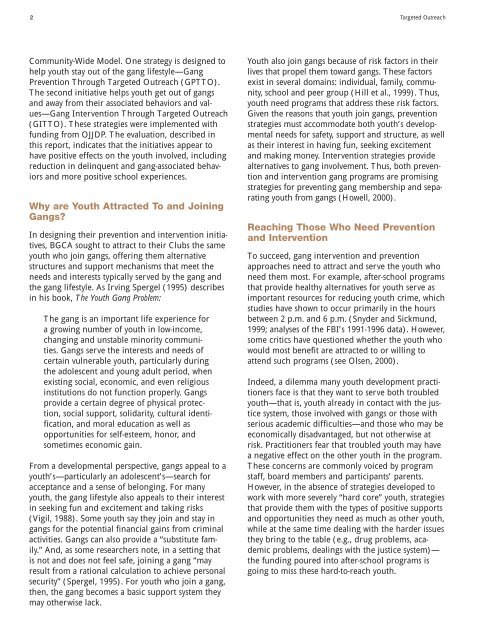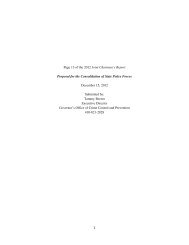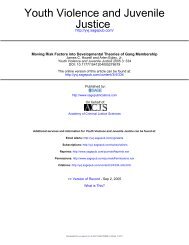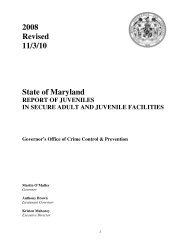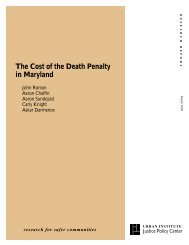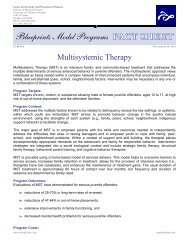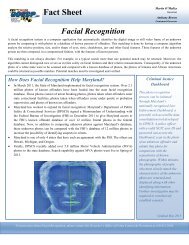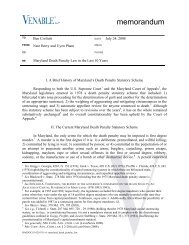Targeted Outreach - Governor's Office of Crime Control & Prevention ...
Targeted Outreach - Governor's Office of Crime Control & Prevention ...
Targeted Outreach - Governor's Office of Crime Control & Prevention ...
You also want an ePaper? Increase the reach of your titles
YUMPU automatically turns print PDFs into web optimized ePapers that Google loves.
2 <strong>Targeted</strong> <strong>Outreach</strong><br />
Community-Wide Model. One strategy is designed to<br />
help youth stay out <strong>of</strong> the gang lifestyle—Gang<br />
<strong>Prevention</strong> Through <strong>Targeted</strong> <strong>Outreach</strong> (GPTTO).<br />
The second initiative helps youth get out <strong>of</strong> gangs<br />
and away from their associated behaviors and values—Gang<br />
Intervention Through <strong>Targeted</strong> <strong>Outreach</strong><br />
(GITTO). These strategies were implemented with<br />
funding from OJJDP. The evaluation, described in<br />
this report, indicates that the initiatives appear to<br />
have positive effects on the youth involved, including<br />
reduction in delinquent and gang-associated behaviors<br />
and more positive school experiences.<br />
Why are Youth Attracted To and Joining<br />
Gangs?<br />
In designing their prevention and intervention initiatives,<br />
BGCA sought to attract to their Clubs the same<br />
youth who join gangs, <strong>of</strong>fering them alternative<br />
structures and support mechanisms that meet the<br />
needs and interests typically served by the gang and<br />
the gang lifestyle. As Irving Spergel (1995) describes<br />
in his book, The Youth Gang Problem:<br />
The gang is an important life experience for<br />
a growing number <strong>of</strong> youth in low-income,<br />
changing and unstable minority communities.<br />
Gangs serve the interests and needs <strong>of</strong><br />
certain vulnerable youth, particularly during<br />
the adolescent and young adult period, when<br />
existing social, economic, and even religious<br />
institutions do not function properly. Gangs<br />
provide a certain degree <strong>of</strong> physical protection,<br />
social support, solidarity, cultural identification,<br />
and moral education as well as<br />
opportunities for self-esteem, honor, and<br />
sometimes economic gain.<br />
From a developmental perspective, gangs appeal to a<br />
youth’s—particularly an adolescent’s—search for<br />
acceptance and a sense <strong>of</strong> belonging. For many<br />
youth, the gang lifestyle also appeals to their interest<br />
in seeking fun and excitement and taking risks<br />
(Vigil, 1988). Some youth say they join and stay in<br />
gangs for the potential financial gains from criminal<br />
activities. Gangs can also provide a “substitute family.”<br />
And, as some researchers note, in a setting that<br />
is not and does not feel safe, joining a gang “may<br />
result from a rational calculation to achieve personal<br />
security” (Spergel, 1995). For youth who join a gang,<br />
then, the gang becomes a basic support system they<br />
may otherwise lack.<br />
Youth also join gangs because <strong>of</strong> risk factors in their<br />
lives that propel them toward gangs. These factors<br />
exist in several domains: individual, family, community,<br />
school and peer group (Hill et al., 1999). Thus,<br />
youth need programs that address these risk factors.<br />
Given the reasons that youth join gangs, prevention<br />
strategies must accommodate both youth’s developmental<br />
needs for safety, support and structure, as well<br />
as their interest in having fun, seeking excitement<br />
and making money. Intervention strategies provide<br />
alternatives to gang involvement. Thus, both prevention<br />
and intervention gang programs are promising<br />
strategies for preventing gang membership and separating<br />
youth from gangs (Howell, 2000).<br />
Reaching Those Who Need <strong>Prevention</strong><br />
and Intervention<br />
To succeed, gang intervention and prevention<br />
approaches need to attract and serve the youth who<br />
need them most. For example, after-school programs<br />
that provide healthy alternatives for youth serve as<br />
important resources for reducing youth crime, which<br />
studies have shown to occur primarily in the hours<br />
between 2 p.m. and 6 p.m. (Snyder and Sickmund,<br />
1999; analyses <strong>of</strong> the FBI’s 1991-1996 data). However,<br />
some critics have questioned whether the youth who<br />
would most benefit are attracted to or willing to<br />
attend such programs (see Olsen, 2000).<br />
Indeed, a dilemma many youth development practitioners<br />
face is that they want to serve both troubled<br />
youth—that is, youth already in contact with the justice<br />
system, those involved with gangs or those with<br />
serious academic difficulties—and those who may be<br />
economically disadvantaged, but not otherwise at<br />
risk. Practitioners fear that troubled youth may have<br />
a negative effect on the other youth in the program.<br />
These concerns are commonly voiced by program<br />
staff, board members and participants’ parents.<br />
However, in the absence <strong>of</strong> strategies developed to<br />
work with more severely “hard core” youth, strategies<br />
that provide them with the types <strong>of</strong> positive supports<br />
and opportunities they need as much as other youth,<br />
while at the same time dealing with the harder issues<br />
they bring to the table (e.g., drug problems, academic<br />
problems, dealings with the justice system)—<br />
the funding poured into after-school programs is<br />
going to miss these hard-to-reach youth.


